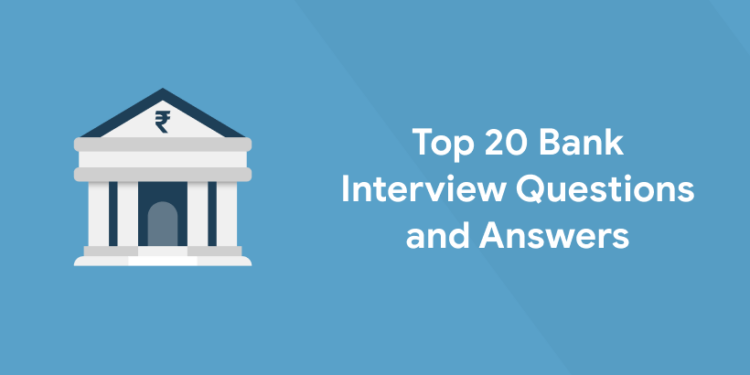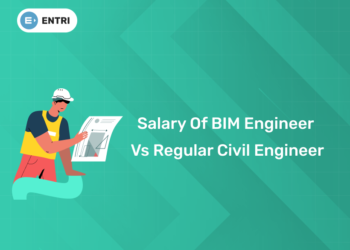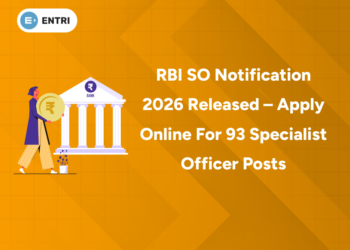When it comes to employment options in the banking industry both new graduates and seasoned professionals from all over the world favour becoming bankers. It’s not easy to get a career in the banking industry; you need the necessary academic credentials, aptitude, sincerity, responsibility, and dedication, as well as experience if you’re not applying for an entry-level position. A position in banking services requires a lot of bank interview answers and questions to pass the interview panel.
Every nation has banks, whether they are on a regional, national, or global scale. The banking and finance sectors offer a variety of entry points for graduates from different academic disciplines, including corporate banking, customer relationship management, researchers, tax analysts, analyst, etc. The employment position you select is based on your major qualification and, if any, prior experience. On this page, we are presenting you the top most commonly asked questions at bank interviews. These questions are as relevant today as they would have been a few years ago.
Click here to learn how to ace your bank interview
The objective of preparing for interview questions is to become comfortable talking about these issues rather than memorizing answers. You will feel more at ease and less on the spot during the interview thanks to your preparation in advance. Choose anecdotes and specific examples from your prior work experiences to share with your interviewers as you formulate your responses. Banking jobs are one of the most sought-after careers today. So if you’re looking to land a great position, here are some tips on what to expect during an interview.
Top 20 Bank Interview Questions and Answers
These popular job interview questions will become extremely familiar if you interview regularly. During your interview preparation, consider feasible answers that will be relevant to the position you’re seeking while showing your talents and expertise. Refresh your interview techniques as well if you want to leave the greatest possible impression. So, here are some of the greatest banking interview questions and answers to assist you to pass the banking interview easily.
Tell me about yourself.
This is a fundamental question used to break the ice between the candidate and interviewers. You can start introducing yourself by saying your name, academic qualifications and any other relevant information you want the interviewer to know. This question almost forms the first impression about a candidate. So confidence is the key to earning these points. Be precise and brief in your self-introduction and end it within one or two minutes. Do not ramble or drag the conversation.
Click to learn tips for bank PO interviews
Why do you want to work in the banking industry?
This is a very common question that gets asked during Bank recruitment interviews. The banking aspirants must answer this question with facts and figures. They can talk about the importance of the banking industry, its growth in recent years as well as its influence over the global economy as a whole. Even though this question is asked to understand the motivation you had to select banking as the profession, it will be better if we avoid answering it with personal information like the stability of job, pay scale, reputation or any other additional benefits.
What is a Commercial Bank?
A commercial bank is where most common people handle their banking. The word commercial bank points to the group of financial institutions that accepts deposits offers checking account services, gives different types of loans and give fundamental financial services like certificates of deposit (CDs) and savings accounts to small businesses and individuals. Commercial banks generate revenue through extending credit, including mortgages, vehicle loans, business loans, and personal loans, and charging interest on those loans. Banks obtain the funding necessary to make these loans from customer deposits. Fees and service charges are another source of income for banks. Depending on the product, these costs may include account fees (such as monthly maintenance fees, minimum balance fees, overdraft fees, and non-sufficient funds (NSF) charges), safe deposit box fees, and late fees. In addition to interest rates, many loan packages also have fees. Commercial banks have a significant role in the economy. They help the market grow by generating cash and liquidity in addition to offering consumers a necessary service.
Register for Entri courses to enhance your banking awareness
What is a Crossed Cheque?
A crossed check is any check that has two parallel lines crossing it, either completely or just through the upper left-hand corner. Due to the check’s double-line designation, it can only be deposited into a bank account. As a result, a bank or any other credit institution cannot cash such checks right away. Crossed checks are a common payment method in Mexico, Australia, and several other European and Asian nations. They give financial institutions clear instructions on how to handle the funds. Crossed checks are most typically used to guarantee that a bank transfers funds into an actual bank account. It is prohibited for such recipient banks to cash such cheques as soon as they are received. Because the cash must be handled through a collection banker, this gives some security to the payer.
What is an Overdraft Protection?
Overdraft protection is an extra feature that stops bank charges that exceed the available cash in the account from being declined. These charges typically include cheques, ATM withdrawals, and debit card payments. The most common use of overdraft protection, also known as cash-reserve checking, is as a safety net for checking accounts, though it can also be used with savings accounts. Even if the account doesn’t have enough money, overdraft protection ensures that the transaction will still be completed by having the bank compensate for the shortfall. When a consumer signs up for overdraft protection, they choose a backup account—typically a linked savings account, credit card, or line of credit—for the bank to utilize as the source to cover any overdrafts. However, the customer is charged by the bank in several ways for this service, such as overdraft fees to handle any transactions that overdraw the account.
Join Entri courses to get banking awareness study materials
What is an Annual Percentage Rate (APR)?
The annual interest produced by a sum that is paid to investors or charged to borrowers is referred to as the annual percentage rate (APR). APR is a percentage that expresses the actual annual cost of borrowing money throughout the course of a loan or the revenue from an investment. This does not account for compounding and includes any fees or additional expenditures related to the transaction. Consumers can evaluate lenders, credit cards, or investment goods using the APR as a benchmark figure.
What is Prime Rate?
The interest rate that commercial banks charge their most creditworthy clients, typically major corporations, is known as the prime rate (prime). The federal funds rate, the overnight rate at which banks lend to one another, is a major factor in determining the prime interest rate, also known as the prime lending rate. Even while prime may not be officially mentioned as a component of the rate ultimately charged, prime serves as the foundation or starting point for the majority of other interest rates, including rates for mortgages, small business loans, and personal loans. In addition to covering the expenses of lending, interest rates compensate lenders for the risk they are taking on based on the borrower’s credit history and other financial information.
Sign up for Entri coaching classes to watch live classes
What is Cost of Debt?
The effective interest rate that a business pays on its debts, such as bonds and loans, is known as the cost of debt. The cost of debt may be expressed as either the before-tax cost of debt, which is the amount owed by the business before taxes, or the after-tax cost of debt. The fact that interest expenses are tax deductible accounts for the majority of the difference between the cost of debt before and after taxes. Understanding the entire rate that a company pays to use different kinds of debt financing is made easier with the help of the cost of debt measure. Because riskier companies typically have a higher cost of debt, the measure can also provide investors with a sense of how risky the company is in comparison to others.
What is Amortization?
Amortization is an accounting method used over a certain period to gradually reduce the book value of a loan or other intangible asset. Amortization of a loan focuses on deferring loan payments over a period of time. Amortization is comparable to depreciation in terms of how it affects an asset. Two scenarios are described by the term “amortization.” First, amortization is a tool used in the process of repaying debt over time with consistent principal and interest payments. An amortization schedule is used to make monthly payments on a loan, such as a mortgage or a vehicle loan, to reduce the current debt. Second, for accounting and tax purposes, the amortization can also refer to the technique of distributing capital expenses associated with intangible assets over a predetermined period, often over the asset’s useful life.
Grab the latest banking awareness notes here
What is Debt-to-income Ratio?
Lenders use the debt-to-income (DTI) ratio, which measures what proportion of your gross monthly income is utilized to pay your debts each month, to assess your risk of borrowing. A low debt-to-income (DTI) ratio indicates that debt and income are well balanced. In other words, if your DTI ratio is 15%, it means that 15% of your total monthly income is used to pay off debt. In contrast, a high DTI ratio can indicate that a person has too much debt relative to their monthly income. Borrowers that have low debt-to-income ratios are typically better able to handle their monthly loan payments. As a result, before offering a loan to a potential borrower, banks and financial credit providers prefer to see low DTI percentages. Since lenders want to make sure a borrower isn’t overextended or has too many debt payments relative to their income, they want low DTI ratios.
What is Adjustment Credit?
A short-term loan that is given by a Federal Reserve Bank to a smaller commercial bank to help it meet reserve requirements and encourage short-term lending is referred to as an “adjustment credit.” Common forms of borrowing between commercial banks and Federal Reserve Banks include adjustment credits. Promissory notes are frequently used by commercial banks to get adjustment credits when interest rates are high and there is a lack of available cash.
Join classes to attend banking awareness recorded classes
What is a Foreign Draft?
When doing international business or financial transactions, foreign drafts might be used instead of foreign currency. In its simplest form, a foreign draught is a bank draught drawn on a financial institution located outside of the country where the required currency is issued. These can be acquired at commercial banks and normally come with a fee depending on the institution and the type of account you possess.
What is Credit-Netting?
Credit netting is a method of reducing the number of credit checks performed on financial transactions by agreeing to simply net all transactions. Large banks and other financial institutions enter into these agreements to consolidate all current and future transactions under one agreement, doing away with the necessity for credit checks on individual transactions. Credit netting is necessary because financial companies frequently have to examine the credit of their clients before approving certain transactions. The danger that the counterparty, or borrowing party, will default on the loan is reduced by investigating the borrowing party’s credit.
What is Loan Grading?
Loan grading is a technique for categorizing loans based on the quality of the collateral, the credit history of the borrower, and the likelihood that the principal and interest would be repaid. A score can also be assigned to a loan portfolio. Loan grading is typically a step in the credit underwriting and approval processes and is a component of a lending institution’s loan review or credit risk system. A loan review system can serve a variety of objectives, including detecting loans with credit problems so banks can take action to reduce credit risk, identifying trends influencing the portfolio’s capacity to be repaid, and for financial and regulatory reporting.
Join to attend a banking awareness mock test
What is an Inter-bank Deposit?
Interbank deposits are a component of the interbank market. Banks and other financial institutions trade currencies through the interbank market. This system excludes retail investors (individuals who buy and sell shares for their account rather than for the account of another firm or organization) and other, smaller trading parties. The majority of interbank trading that takes place on the market is proprietary, meaning that banks trade with and for one another. But there are times when this kind of banking is done for huge, institutional clients. Banks borrow and lend money in the interbank market from one another to manage liquidity and satisfy regulatory reserve requirements. The quantity of money a bank must store in its safes is known as a reserve requirement. Loans and deposits are just two of the numerous kinds of transactions that take place between banks to help them fulfil these requirements. A significant amount of liquidity is also provided to the market by these trades. A due to account is set up by the holding bank for the corresponding bank—the institution making the deposit—when two banks agree to an interbank deposit. The payable account, commonly referred to as a holding account, is the due to account.
What is an Irrevocable Letter Of Credit (ILOC)?
An irrevocable letter of credit (ILOC) is a formal document issued by a bank that serves as a guarantee of payment for goods or services acquired by the person or organization, known as the applicant, who requests the letter of credit from the issuing bank. Except with the express consent of the Buyer, Seller, and Issuing Bank, an irrevocable letter of credit may not be revoked or otherwise modified. For instance, once an ILOC has been issued, the issuing bank does not have the power to alter any of the terms by itself. The use of letters of credit has grown to be a critical component of global trade because of the nature of international business, which includes elements like distance, different regulations in each country, and the challenge of knowing each participant personally.
Register to attend bank PO mock interviews
What is a Cashier’s Cheque?
A cashier’s cheque is a safe method of making large payments. A financial institution, such as a bank or credit union, writes the cheques against its own funds. When you ask your bank for a cashier’s cheque, money is transferred from your account to the bank’s account, and then a bank representative (usually a teller) signs it over to a named third party. (The cheque will include both the recipient’s and the remitter’s names.) A customer who purchases a cashier’s cheque pays the full face value of the check plus a small fee for the service. In some cases, the advantages and protections provided by a cashier’s cheque make it a better choice than a personal cheque.
What is a Home Equity Loan?
A home equity loan is similar to a mortgage, hence the term second mortgage. The lender uses the equity in the home as collateral. The amount a homeowner can borrow will be determined in part by a combined loan-to-value (CLTV) ratio of 80 per cent to 90 per cent of the home’s appraised value. Of course, the loan amount and interest rate are also determined by the borrower’s credit score and payment history. Traditional home equity loans, like conventional mortgages, have a set repayment term. The borrower makes consistent, fixed payments that cover both principal and interest. If the loan is not paid off, the home may be sold to satisfy the remaining debt, as with any mortgage. A home equity loan can be a great method for converting the equity in your home into cash, especially if you use that cash to make home improvements that increase the value of your home. However, keep in mind that you are putting your home at risk—if real estate values fall, you may end up owing more than your home is worth. If you decide to relocate, you may lose money on the sale of your home or be unable to do so. Furthermore, if the loan is being used to pay off credit card debt, resist the urge to use your cards again. Consider all of your options before taking action that could jeopardize your home.
Get the best tips for attending bank interviews here
What is a Line of Credit?
All LOCs have a fixed amount of money that can be borrowed, paid back, and borrowed again. The lender determines the amount of interest, the size of payments, and other rules. Some LOCs permit you to write cheques (drafts), whereas others include a credit or debit card. A LOC can be secured (backed by collateral) or unsecured, with unsecured LOCs typically carrying higher interest rates. The main advantage of a LOC is its inherent flexibility. Borrowers may request a specific amount, but they are not required to use it all. Rather, they can tailor their LOC spending to their needs and pay interest only on the amount drawn, not on the entire credit line. Borrowers can also change their repayment amounts as needed based on their budget or cash flow. They can repay the entire outstanding balance at once, for example, or just the minimum monthly payments.
What is ACH?
ACH transfers are electronic money transfers between banks that are processed through the Automated Clearing House (ACH) Network. The ACH network, according to Nacha, the organization in charge of these transfers, is a batch processing system that banks and other financial institutions use to aggregate these transactions for processing.
Sign up for the best tips to ace bank interviews
So, here are the sample questions that are commonly asked in bank interviews. So be prepared, these bank interview questions are crucial for getting hired in any bank around the world. Download the Entri app and let us help you anticipate the common types of questions asked in a banking interview and formulate answers that are engaging. Many banks have common interview questions for their job interviews. Here is a compilation of the most commonly asked questions. Use this list of questions as a guide and be sure to study the job description and research the company.










